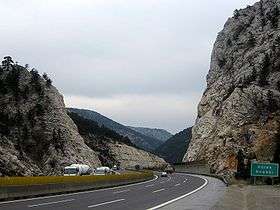Caracalla's inscription
| Material | Stone |
|---|---|
| Writing | Latin |
| Created | 216 AD |
| Present location | Cilician Gates, Taurus Mountains, Turkey |
Coordinates: 37°17′08″N 34°47′10″E / 37.28556°N 34.78611°E


Caracalla's Inscription (Turkish: Gülek Kitabesi, also called İskender Kitabesi) is a rock-carved ancient Roman inscription on the Taurus Mountains, southern Turkey dedicated to the Roman emperor Caracalla.
Location
The inscription is situated at the Cilician Gates (Turkish: Gülek Boğazı), which is located north of Tarsus district in Mersin Province at 37°17′08″N 34°47′10″E / 37.28556°N 34.78611°E. Formerly visible to the passers-by on the highway, it is not the case today due to the elevated level of the motorway ![]() constructed on place later on.
constructed on place later on.
The location is accessible taking the exit at Akçatekir and following the regional road east of the motorway southwards about 5 km (3.1 mi).[1]
Etymology of the inscription
Locally, it is dubbed as the "İskender Kitabesi" ("Alexander's Inscription"), although Alexander the Great lived about five centuries before Caracalla. The local name was most likely given due to the historical fact that Alexander the Great (reigned 331–323 BC) passed through the Cilician Gates proceeding for the Battle of Issus.[1] Even though it revealed after its decryption that the inscription was dedicated to Caracalla (reigned 198–217 AD), the wrong local name still persists.
The inscription
The inscription was put up to memorize the road-widening construction of the mountain pass for the troops of Caracalla proceeding to the Parthian war in 216–17 AD. The inscription in Latin reads as:
- Empreror Caesar Marcus Antoninus, the faithful, blessed, invincible Augustus (Caracalla), constructed this road by digging through the mountains.[1][2]
Below the inscription, there are two lines written in Ancient Greek, which reads as Border of Cilicia marking the border to Cappadocia in the north.[1][2]
In conjunction with the inscription, there exist several milestones to the north of the Cilician Gates. Some of the milestones are now in Adana Archaeology Museum. The milestones bear the name of the road in Latin as Via Tauri ("Taurus road").[1][3]
References
- 1 2 3 4 5 "Tarsus" (in Turkish). Mersin İl Kültür ve Turizm Müdürlüğü. Retrieved 2016-10-01.
- 1 2 Semihi Vural: Anadolu'nun Kapısı Gülek, ISBN 978-605-5274-07-8 p.74
- ↑ Mersin Ören Yerleri Kaleleri, ISBN 978-605-4196-07-4 , p.95